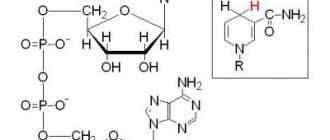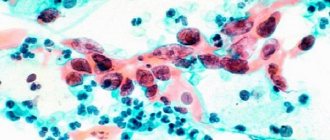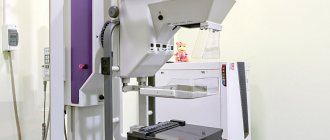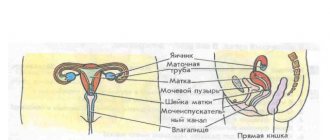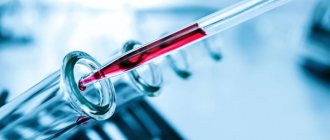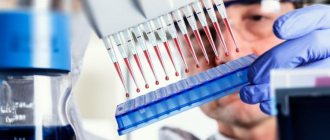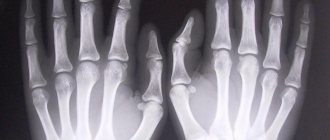Cancer is a malignant formation whose cells divide uncontrollably, multiply and grow into nearby tissues. Malignant cells have the ability to secrete poisons and harmful substances in order to destroy healthy ones and germinate into them. As a result, the tissue at the site of the tumor begins to become inflamed.
Because of this, the ESR or erythrocyte sedimentation rate in the blood increases, as well as the number of leukocytes. They try to fight the antibodies that the tumor produces. That is why, during a general (clinical) blood test, the doctor may suspect something is wrong and send the patient for additional diagnostics.
Category: Pen stroke 01
The patient may not even be aware of a malignant neoplasm that has arisen in the body for a long time.
As a rule, this “formidable” pathology develops asymptomatically at first, and this is where its insidiousness lies. The presence of a malignant tumor and its progression is indicated by changes in the blood test, including deviations from the norm in ESR values.
Acceptable erythrocyte sedimentation rates
The erythrocyte sedimentation rate in the blood normally depends not only on the gender of the patient, but also on age. Its deviations in the direction of decrease or increase indicate processes of disharmonization in the body, not necessarily in the direction of disease. ESR levels are affected by hormonal imbalances, menstrual cycles in women, pregnancy, and the postpartum period.
Established standards for erythrocyte sedimentation levels are:
- in babies in the first six months of life - no less than 2 mm/h and no more than 5 mm/h;
- in babies in the second six months of life - no less than 4 mm/h, and no more than 10 mm/h;
- in children from one year to 11 years – within 2-12 mm/h;
- in adolescents from 11 to 18 years old – within 2-12 mm/h;
- women - not lower than 2 mm/h, and not higher than 15 mm/h;
- men - not lower than 1 mm/h, and not higher than 10 mm/h.
An elevated erythrocyte sedimentation rate is considered a cause for concern if it rises significantly above established norms.
A slight increase in ESR in women, as a rule, does not alarm specialists, since this indicator directly depends on the state of hormonal metabolism. In women, it is often disrupted while taking hormonal contraceptives, during menopause, and during pregnancy.
The main reasons to sound the alarm
An increased ESR can be considered a sign of many diseases of an inflammatory and chronic nature. At the same time, as a rule, the clinical picture of blood has a changed composition in other indicators. For example, ESR in oncology increases markedly against the background of an equally noticeable decrease in hemoglobin.
Experts can suspect the occurrence and development of a malignant neoplasm in the body if:
- a sharp deviation of the ESR norm towards an increase to 70 mm/h or more;
- no decrease in the red blood cell sedimentation rate during anti-inflammatory drug therapy;
- reducing hemoglobin levels in the blood to 70-80 units.
ESR increases already at the first “asymptomatic” stage of cancer, so this analysis often helps to identify cancer pathology in a timely manner and take therapeutic measures in a timely manner.
Where to look for pathology
The changed level of the clinical indicator of erythrocyte sedimentation rate in the blood, first of all, prompts specialists to search for acute inflammatory pathology in the body. If the inflammatory process cannot be detected, then there is reason to suspect cancer pathologies. As a rule, high ESR values are diagnosed:
- for intestinal cancer;
- breast oncology;
- bone marrow cancer;
- malignant neoplasm in the cervix;
- cancer pathologies of the lymphatic system;
- ovarian oncology in women;
- lung cancer;
- benign intestinal neoplasms.
The red blood cell sedimentation rate itself is not a 100% indicator of cancer pathology. Most often, specialists use this method to track the dynamics of tumor progression in cancer.
Important help for timely diagnosis
Since the analysis involves the determination of many indicators, its decoding helps answer a number of important diagnostic questions:
- What is the erythrocyte sedimentation rate?
- How many platelets and leukocytes are determined by the clinical picture of the analysis?
- Quantitative composition of hemoglobin? How much is the deviation from the norm?
The ratio of these indicators will help the specialist determine the location of the possible localization of tumor pathology. For example, with an intestinal tumor, ESR indicators can reach a critical value - up to 60-70 mm/h, and the hemoglobin level sometimes critically decreases to 60 units. High rates of erythrocyte sedimentation rate are also recorded in lung cancer, but this formidable pathology can only be suspected against the background of a change in the pattern of platelets and leukocytes. Intestinal oncology, in turn, leaves the picture of the leukocyte formula almost unchanged.
Basic analysis for the presence of pathology
Despite the high degree of information content of a general analysis of blood composition, experts do not recommend relying only on these data when making a diagnosis. Some very serious pathologies do not fit into the clinical scheme and are difficult to diagnose using tests:
- Peripheral lung tumors are practically asymptomatic, and the ESR level may increase slightly. It reaches a critical value only when the disease enters the terminal stage.
- Right-sided intestinal tumors. Against the background of a slight increase in ESR, a strong drop in hemoglobin levels can be diagnosed against the background of mildly erased symptoms of intestinal disorders.
If the patient has an established cancer diagnosis, a general blood test for the amount of ESR will help to effectively monitor the dynamics of the tumor process.
Monitoring the clinical picture of ESR will help you understand in time whether the drugs for tumor therapy are selected correctly. Monitoring is especially important for lung and intestinal oncology, since there is a risk of the tumor entering the latent stage.
By constantly monitoring the erythrocyte sedimentation rate, the doctor is able to control the dynamics of the tumor process: when the growth and progression of cancer is inhibited, ESR indicators decrease, and during an exacerbation they increase sharply.
Experts point out that high ESR levels cannot necessarily be considered an indicator of a tumor process. If all three components even come together in the analysis - ESR, hemoglobin, leukocyte formula - this will serve as a reason for an extensive additional study.
The most common cancer pathology among the male population of the planet is considered to be the occurrence of which is caused by the penetration of various types of carcinogens into the pulmonary system, such as chemical industrial emissions, impurities in hazardous industries, etc.
Cancer processes do not appear immediately, so patients often turn to an oncologist with an advanced disease, which rarely responds to therapeutic intervention.
ESR: what is it?
ESR and ROE - erythrocyte sedimentation reaction are the same, but the latter abbreviation is considered outdated. ESR shows the intensity of red blood cell aggregation followed by their sedimentation to the bottom.
The clumping of red blood cells is enhanced in the presence of the protein fibrinogen, which is involved in the formation of blood clots and is normally practically absent in plasma. A decrease in the largest fraction of proteins - albumin and an increase in numerous protein fractions of globulins - gamma, beta and alpha changes the ESR towards an increase.
The sedimentation rate will certainly change if the erythrocyte has an abnormal shape and non-standard size, which is typical for anemia of various etiologies, including those caused by complications of chemotherapy.
Any pathological process - infection, inflammation, tumor, especially a malignant blood disease, affects the ratio of blood proteins and, of course, can shift the indicator in one direction or another.
How does the cancer process begin in lung tissue?
The primary symptoms of lung cancer are important, because their timely detection prompts the patient to visit a specialist and helps to diagnose oncological processes in the early stages of their development.
The following manifestations indicate the onset of pulmonary oncology:
- Frequent and causeless, difficult to treat pulmonary inflammation and bronchitis;
- Frequent shortness of breath, first after physical exertion, and then at rest;
- Cough, initially dry, and then accompanied by sputum production. Coughing attacks occur suddenly and are rarely disturbing, but with further progression of the oncological process they occur more often, accompanied by the release of sputum with bloody streaks;
- Chest pain;
- Persistent and causeless hyperthermia of a subfebrile nature (37.5-38°C);
- Angina disorders;
- Depressive state associated with chronic fatigue.
Information content
Many sites write that this analysis allows you to detect cancer in the early stages. It may give the doctor a hint that there may be something wrong with the patient, but the test does not provide any information about cancer. Even a biochemical analysis gives more than a general analysis, since with it some oncology can be seen immediately and even the localization of the disease can be traced.
Even a blood test for tumor markers does not give a 100% chance that you have cancer. Let us recall that tumor markers are antibodies, proteins and waste products of the tumor that it secretes during growth. And even this super test does not give the doctor a 100% chance of cancer. That is why you need to undergo other examinations first.
Indications for examination
The most common diagnostic method is a blood test. But a general study does not provide the necessary picture of the condition at the initial stages of the oncological process. Therefore, specialists have been looking for other ways to early diagnose lung cancer for a long time.
A solution was recently found. It is a blood test that determines the presence of specific protein substances that are produced by the body or tumor from the very beginning of the cancer process. Therefore, these proteins are present in the patient’s body from the beginning of tumor formation, when there are still no signs of the development of lung cancer.
Some protein substances are particularly unique and are detected only in the presence of a certain oncology, others are universal tumor markers and are detected in a variety of tumor processes.
The research allows:
- Detect a tumor at the initial stage of its occurrence;
- Determine the nature of the neoplasm, the degree of its malignancy;
- Timely detect metastasis of the tumor process;
- Determine the effectiveness of therapy and monitor the progression of pathology;
- Avoid possible exacerbation or recurrence of the tumor;
- Prevent the occurrence of cancer, for example, in people at risk of cancer.
And yet it is impossible to say for sure about the presence of cancer only from the results of blood tests. Therefore, it includes a whole range of studies.
Let's sum it up
To summarize, it should be noted that you should not panic in case of high indicators, since this phenomenon can indicate both harmless processes in the body and more serious pathologies. But, you need to take into account the fact that in a healthy person, the ESR concentration should be at a certain level. Any deviation of this indicator is not normal and serves as a reason for undergoing a comprehensive examination prescribed by a doctor.
A comprehensive examination includes: tests for tumor markers, detailed blood and urine tests, modern instrumental examinations, such as MRI, CT, ultrasound. Only by examining the results of all the data can one exclude or establish the presence of cancer.
How to detect pathology using blood?
A laboratory blood test shows the level of erythrocyte and leukocyte cells, hemoglobin content, sedimentation rate, etc.
When conducting biochemical and tumor marker analysis, specialists receive more accurate and informative data regarding the patient’s condition.
The group of such patients includes:
- Smokers;
- People with a hereditary predisposition to lung cancer;
- Those who are employed in hazardous industries, work with heavy metals or toxic chemical compounds;
- Those suffering from chronic respiratory pathologies such as obstruction or pneumosclerosis, etc.;
- Those in contact with radon;
- Those living in environmentally unfavorable areas, large cities with air polluted by exhaust gases, etc.
Is there a relationship between ESR levels and cancer?
From the practice of oncologists, the sedimentation rate gives deviations when other diseases occur. The normal ESR level in the blood of women depends on hormonal levels during the cycle, menopause, and pregnancy. The indicator differs between women and men, people of different ages and the presence of chronic diseases. The cause of the disorder can be determined by laboratory and instrumental examinations.
An increased ESR means the occurrence of a serious inflammatory process, but what is the cause is revealed by a more thorough examination - laboratory and instrumental.
Complete blood count for lung cancer
During a general blood test, biomaterials are removed from a finger (from a capillary) on an empty stomach in the morning.
On the eve of blood sampling, it is not recommended to eat fatty, hard-to-digest foods, because an increased content of leukocytes will be detected in the blood. In addition, stress, physical overexertion, etc. distort the results.
With pulmonary oncology, the general blood test indicators show some changes. For example, red blood cells begin to sediment at a higher rate, and the higher it is, the more serious the pathology. Typically, an ESR of about 10-50 mm/h indicates rapid progression of tumor processes.
The level of hemoglobin is also considered indicative, which for specialists acts as a kind of indicator indicating the development of a tumor.
Against the background of progressive oncological processes, hemoglobin levels are often about 60-70 units. In addition to red blood cells and hemoglobin, an increased level of white blood cells may also indicate the presence of cancer.
Therefore, the CBC often turns out to be very informative, but the presence of a tumor cannot be judged from this study alone. The identified deviations in the general study indicate the need for a comprehensive examination.
More accurate diagnosis
- At the first stage, you need to contact any therapist and take general and biochemical blood tests, urine and feces. Blood may be found in the urine and stool, which may indicate a tumor in the genitals and intestines.
- Typically, the initial phase of almost any cancer is quiet, and most of the first symptoms are similar to a normal disease. And this is where home self-diagnosis will help you.
- It is necessary to go for fluorography to rule out lung cancer and do an ultrasound of the abdominal cavity. For women, you need to: go to a mammologist, gynecologist, have a mammogram and an ultrasound examination of the pelvic organs.
- After this, the doctor makes a preliminary diagnosis of the presence of a tumor (if found).
- Next, the doctor needs to find out the stage of the tumor, its malignancy, size, damage to nearby tissues, and differentiation. To do this, more accurate diagnostics are carried out: MRI, CT, Biopsy, etc.
( 1 ratings, average: 5.00 out of 5)
Biochemical
A biochemical blood test can also show a specialist that the patient is developing a tumor pathology. About 12 hours before blood collection, the patient should refuse food and drink only plain water.
In case of lung cancer, biochemical blood parameters will contain the following information:
- Increased content of α-2-globulin;
- Serum albumin deficiency;
- Excess calcium levels;
- Excessive levels of lactodehydrogenase;
- Increased cortisol.
Biomaterials are taken from a vein, and after 3-5 days a repeat biochemical study is performed. Such actions are necessary to monitor the dynamics of tumor markers.
Where can I get tests done?
A blood test for ESR is carried out in every city in every region of Russia. Typically, diagnostics are carried out in the laboratory of the medical institution where the patient is observed, but you can also use the services of private specialized companies on a paid basis.
Where can you get tested for ESR in Moscow?
- Medical, Khoroshevskoe highway, 12. Price 325 rubles.
- Clinic of restorative medicine "Eleos", Oktyabrsky Prospekt, 24. Cost 250 rubles.
- Clinic “Human Health”, Osenny Boulevard, 12. Price 150 rubles.
Where can I go for a blood test for ESR in St. Petersburg?
- Clinic "Family Doctor", st. Academician Pavlova, 5. Cost 250 rubles.
- Medical, st. Ryleeva, 3. Price 150 rubles.
- Clinic "Blagodatnaya", st. Yu. Gagarina, 1. Cost 200 rubles.
Also, Invitro clinics operate in almost all regions of Russia, where you can conduct blood diagnostics any day, seven days a week, and in the shortest possible time. The cost of ESR analysis varies depending on the city and averages from 150 to 260 rubles. Additionally, you need to pay 199 rubles for blood sampling from a vein. for all regions.
Analysis for cancer markers
As previously specified, the tumor produces specific protein substances, which are also called tumor markers or antigens.
In accordance with the type of tumor markers, the localization of the cancer process can be determined. Normally, body cells inhibit the production of antigens, so their presence in the blood indicates the presence of an oncological process.
Such blood tests must be carried out many times in order to track the dynamics of tumor processes. Such studies make it possible to determine the rate of increase in the concentration of tumor markers, which will help predict the progression of the tumor process.
Tumor markers for lung cancer are also taken in the morning; blood is drawn from a vein for testing. It is necessary to avoid alcohol a few days before the test.
Such diagnostics are expensive, and the results may be inaccurate. Levels of some tumor markers increase against the background of myocardial failure and hepatitis, liver cirrhosis and gastric ulcers, pancreatitis, etc.
Tumor markers
The most commonly used tumor markers for diagnosing lung cancer are:
- CEA
is a universal tumor marker that helps determine the presence of cancer pathology in 50-90% of patients. This is a cancer-embryonic antigen, the level of which rises not only in cancer, but also in liver cirrhosis; - TPA
– tissue polypeptide antigen, is a common antigen produced by various formations; - NCE
or neuron-specific enolase - used to detect small cell types of lung cancer; - SCC, CYFRA 21-1
- used in the process of identifying squamous cell forms of lung cancer or adenocarcinoma.
A slight excess of antigen levels in the blood may be due to less “aggressive” processes than cancer, so this analysis must be combined with other diagnostic procedures.
What analysis determines the rules for submission?
Calculation of the rate of deposition of red formed elements is carried out using Panchenkov. This is the most cost-effective and fastest way. There are also Westergren and Wintrobe techniques, which are used less frequently. In the laboratory there are special devices designed to measure the speed of bonding of shaped elements. To do this, you need to take blood from your finger and 5% Na citrate. The components are mixed in a ratio of 1:4 and the process is monitored for 1 hour. After this time, the height of the column of red blood cell accumulation is determined. This is the ESR value.
Preparing for the study
The erythrocyte sedimentation rate may be elevated in healthy people because it is sensitive to external and internal environmental factors. To minimize deviations, you must adhere to the following rules:
- It is better to donate blood in the morning or in the first half of the day on an empty stomach.
- The dinner before the diagnostic event should be low-calorie and light.
- 3 days before the procedure, it is better to avoid fatty, fried foods and alcohol.
- You should not smoke 3 hours before the test.
- It is not recommended to engage in heavy physical work 3 days before donating blood.
- It is necessary to cancel physiotherapeutic procedures the day before the examination.
Preparation for delivery
Blood tests are always taken on an empty stomach and only in the morning; you can have your last meal before the test 8-12 hours before. The only drink allowed is water.
About a week before the tests, you need to avoid alcohol, and an hour before the tests, you need to avoid smoking. In addition, in order not to reduce the information content and reliability of blood tests, you should not go to the procedure in a state of stress, nervous strain, sleepless night, or physical overload.
If the patient has already been treated, then repeated tests for tumor markers are taken every 3 months. Usually, immediately after therapy, the concentration of antigens drops sharply, but if such a reaction is absent, then a change in the therapeutic approach is necessary.
Video about preparing for a blood test:
Many people diagnosed with cancer constantly have an increased ESR value in their tests. But a high ESR (average erythrocyte sedimentation rate) does not confirm that a person has a malignant disease.
Norm
ESR in a blood test is not a constant indicator. Its level depends on several factors. Even the time of day matters. So, during the day the value is higher than in the evening. During pregnancy, ESR is always higher than normal, especially in the second trimester. If the woman’s health is satisfactory, then this fact does not bother the doctors. Approximately three weeks after birth, these indicators should be normal.
Norms also depend on age and gender.
| Women | Men | Children | |||||
| From 15 to 60 years | Over 60 years old | From 15 to 60 years | Over 60 years old | Newborn | From 1 to 6 months. | From 1 year to 10 years | From 10 to 18 years |
| 2-15 mm/h | 2-20 mm/h | 2- 8 mm/h | 2-15 mm/h | 2-5 mm/h | 5-15 mm/h | 1-10 mm/h | 2-15 mm/h |
As can be seen from the table, the values for men and women differ. Experts explain this phenomenon by the fact that in women, due to physiological characteristics, the number of red blood cells is lower, and therefore their sedimentation rate is faster.
ESR in the blood in cancer
Rather, this value indicates that processes of an infectious or inflammatory nature are occurring in the body. An ESR value in constant tests of about 75 mm/h and above gives the doctor reason to assume the presence of an oncological process or an emerging tumor, but in any case, this requires further diagnostics to confirm this diagnosis.
ESR values over 100 mm/h, according to many scientists, are irrefutable evidence that the tumor is not only present, but also spreads metastases beyond the site of the disease that was first diagnosed. ESR also has the highest rate.
What else could an elevated level indicate?
A high erythrocyte sedimentation rate often shocks the subject. Does ESR always increase in cancer?
However, a high ESR is not always a sign of cancer; this feature is recorded when:
- Acute infections;
- Chronic inflammatory processes;
- States of immunodeficiency (HIV, hepatitis);
- Autoimmune diseases;
- Anemia and decreased hemoglobin levels;
- Pathologies of blood clotting;
- Atrophy of organ tissue due to poor blood supply;
- Injuries and fractures;
- Intoxication (food, respiratory, skin poisoning);
- Severe burns;
- Amyloid dystrophy;
- Menstruation and pregnancy;
- Taking certain medications (estrogens, glucocorticosteroids);
- Shock or postoperative states.
What is ESR for cancer?
Oncological practice uses high erythrocyte sedimentation values for 100% reliability of the disease in only one case - multiple myeloma, a malignant disease of the bone marrow, where there is uncontrolled proliferation of plasma cells.
With this disease, the patient experiences severe pain due to destructive changes in the bone skeleton. The body synthesizes huge amounts of immunoglobulin in an abnormal form thanks to atypical plasma cells.
Immunoglobulins are proteins that cause the creation of so-called “coin columns” of red blood cells. In multiple myeloma, the emphasis is on them, causing high ESR levels. Therefore, it is believed that an ESR over 100 mm/h is a basis for making a diagnosis of multiple myeloma.
Malignant disease of the lymph nodes (lymphogranulomatosis, Hodgkin's disease) is also always accompanied by high ESR values. Doctors do not make a diagnosis based on this value, but monitoring the disease and the effectiveness of the prescribed treatment is based on these values.
Serious deviations
The combination of deviations and changes in the composition and structure of blood, organ tissues, and enzymes determines the occurrence of a tumor. The doctor prescribes general and biochemical blood tests for patients.
General blood analysis
Primary stage of diagnosis. Its goal is to identify disturbances in the oncological development of the disease. In addition to ESR and hemoglobin in the blood test, red blood cell counts decrease from normal 3.7-4.7 cells/l for women and 4-5.3 cells/l for men.
There is an increase in leukocytes at a rate of 4 to 9 * 109 cells/l. The level of platelets, the volume of red cells changes, and blood clotting worsens. If you maintain a healthy lifestyle and diet, such changes cannot but be alarming. When blood is magnified under a microscope, the presence of lymphoblasts will be a direct indication of a tumor.
Biochemical analysis
It helps to identify disorders in internal organs and metabolism. All data are considered as a whole and do not determine the diagnosis individually.
The negative survey scenario is the following indicators:
- Increased sugar and tumors in the pancreas. The norm is from 3.3 to 5.5 mmol/g.
- C-reactive protein – up to 5 mg/l. A higher level is an indicator of the inflammatory process.
- Urea. Concentration 2.5-8.3 mmol/g.
- Creatinine – 44-106 mmol/l.
- Alkaline phase. The norm is 30-120 units/l. Its increase is characteristic of bone cell damage.
- Liver enzymes. Deviations from the norm indicate the occurrence of a tumor in the gall bladder or liver. The norm for AST is 20-40 units/l, ALT is 30-32 units/l.
- Elevated protein levels mean metabolic disorders.
Other cases of increased ESR in the blood
The ESR rate also increases significantly when the body is infected. When an infection enters the body, cells begin to intensively produce immunoglobulins (antibodies), trying to strengthen the immune response to the threat posed by the infection. All cells try to increase the formation of red blood cell columns, protecting the body from damage.
As a result of such a “fight” within the body between infection and immunity, the ESR can increase significantly. At the same time, it has long been noted that with bacterial infections the ESR is usually higher than with a viral infection.
For people with chronic diseases, an ESR value of at least 70 mm/h is typical. Usually these are patients who have been diagnosed with tuberculosis, subacute bacterial endocarditis, etc. However, any manifestation of a bacterial infection leads to an increase in ESR.
Cancer claims millions of lives every year. Doctors never tire of repeating that the only way to avoid death is early diagnosis and persistent treatment under the guidance of a specialist in a medical institution. The development of cancer is first recorded by blood tests: the level of leukocytes, hemoglobin, ESR in oncology is noticeably higher than the standards characteristic of a healthy person.
Bowel cancer, symptoms
Cancer is an asymptomatic disease. Specialists prescribe a blood test if bowel cancer is suspected, after certain symptoms have appeared:
- A vague symptom may simply be abdominal pain, but there is intestinal bleeding, which can be seen during a stool occult blood test.
- The occult blood test can even be performed at home. If the first test for cancer, a home occult blood test, is positive, then a colonoscopy should be performed. Now it is done under anesthesia.
- Problems with stool - this can range from frequent constipation to diarrhea.
- Gas incontinence, especially during exercise.
- Constant desire to go to the toilet “in a big way”, lack of feeling of emptiness.
- Fecal incontinence.
- Bloating.
- With partial or complete intestinal obstruction, cramping and frequent abdominal pain.
- Anemia, general weakness.
- Vomiting caused precisely by urges from the intestines.
- Nutrients are poorly absorbed, resulting in weight loss.
If you notice several of these symptoms, you should see a doctor as soon as possible. A timely blood test for colon cancer can alleviate your condition and even save your life.
Oncology: briefly about the disease
Today, oncology is recognized as the main and main cause of premature death, sharing primacy with cardiovascular diseases.
Under certain conditions, the well-coordinated functioning of cells in the human body fails: some of them degenerate and begin to rapidly divide, resulting in the formation of a tumor in place of the cell, which quickly gains weight and size. The process affects blood parameters, since it is the main carrier of information about the state of organs, the first to give signals about changes occurring.
Doctors do not have a specific answer about the causes of cancer cell failure. The “culprits” are seen in constant exposure to a polluted atmosphere, chemicalization of food products, bad habits (alcohol, smoking), and hereditary predisposition. But these are only well-known, standard reasons for the transition of healthy cells to malignant ones.
It has not yet been possible to discover the true mechanism of cancer formation in the body.
It’s not for nothing that cancer is called a “killer in soft slippers”: a person may not suspect for years that a fatal disease is already gaining strength in his body.
When examining the material in the laboratory, they will indicate in detail the data of all components contained in the blood. Based on the examination results, the doctor will determine the presence/absence of a tumor process, based on the indicators of the “three pillars” of blood - leukocytes, hemoglobin, erythrocytes.
Hemoglobin in oncology
Hemoglobin is a specific protein that is part of red blood cells and transports oxygen from the lungs to all organs and tissues, as well as carbon dioxide on the way back.
Low hemoglobin and oncology may be related to each other, since a decrease in the indicator is recorded in more than 60% of patients. This condition has its own definition - anemia (anemia).
We suggest you read: How to get rid of calluses between your toes?
Normal levels of hemoglobin in the blood of a healthy person:
- men – from 130 to 174 g/l;
- women – from 110 to 155 g/l.
Deviations of several units in any direction do not have any effect on the general condition of a person. But in the presence of a malignant tumor, anemia, shock, severe infections, etc. the content of this blood component begins to decrease.
A decrease in hemoglobin levels is indicated by a set of symptoms:
- general malaise;
- attacks of acute pain in the chest;
- rapid onset of shortness of breath even when walking calmly;
- dizziness;
- pale skin;
- brittle nails and hair loss;
- cold sweat;
- heart rhythm disturbances;
- reduction of the body's natural defenses (immunity).
How the research is carried out
It is useful to take a blood test regularly - once a year; upon reaching 45 years of age, it is recommended to conduct the test more often - every six months. This is the only way to promptly pay attention to an increased ESR, whose indicators are decisive in intestinal oncology, for example. However, a general analysis is not enough to confidently talk about the presence of cancer - the erythrocyte sedimentation rate increases during the inflammatory process, therefore, for an accurate diagnosis, more detailed tests and additional examination are needed to determine the presence of an oncological process in the body.
In public medical institutions, blood is tested for ESR using the Panchenkov method. The essence of the method: the material (capillary blood) is placed in a graduated vertical vessel along with a substance that inhibits clotting. Gravity separates the blood into plasma and red cells, and red blood cells gradually sink to the bottom, separating from the plasma. The rate of sedimentation is recorded on a millimeter scale of numbers - how many marks the red cells have dropped per unit of time (1 hour). These numbers are called ESR - erythrocyte sedimentation rate.
How to get tested
You need to take the test calmly, it’s too late to get nervous - everything has already happened in the body and all that’s left is to get the information. It would be more correct to pose the question differently: where to take it. It is advisable for an oncology patient to undergo tests in a specialized institution, where not only analysis on the machine is available, but also monitoring of the results obtained “in manual mode”. With specific treatment, especially after the use of medications, the conventional boundary of normality of indicators may temporarily shift. Often, haste in interpreting the result results in excessive examination and unnecessary treatment.
If you want an optimal and unconditionally professional approach, accuracy and objectivity, come for a consultation at our clinic.
Book a consultation 24 hours a day
+7+7+78
Bibliography
- Lugovskaya S.A., Morozova V.T., Pochtar M.E., Dolgov V.V. /Laboratory hematology// M.: Publishing house. Unimed-press; 2002.
- Pervushin Yu.V., Lugovskaya S.A., Marchenko L.A., Kovalevich N.I. / Hematological studies in clinical laboratory diagnostics//Stavropol; 2006
- Nazarenko G.I., Kishkun A.A. / Clinical assessment of laboratory research results // M., 2000.
- Oganesyan A.A., Garbatsevich M.S., Kostyukovich D.I. and others /ESR: old test, new opportunities // Lab. diagnostics. Eastern Europe; 2012; No. 4.
- Chizhevsky A. L. /Biophysical mechanisms of erythrocyte sedimentation reaction// Novosibirsk: Science, 1986.
